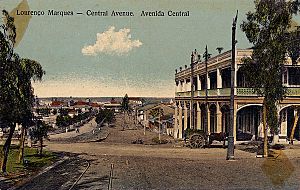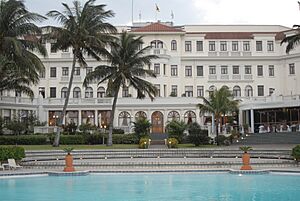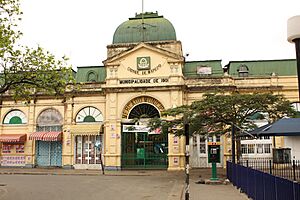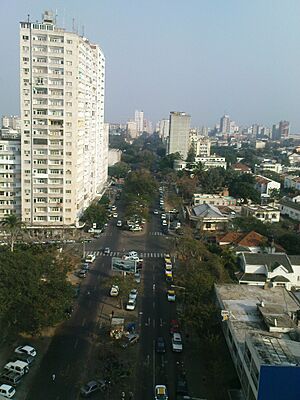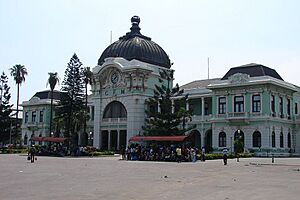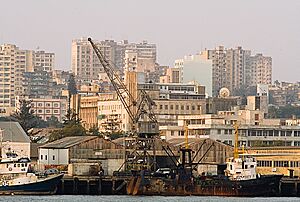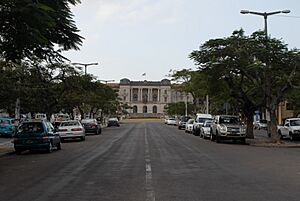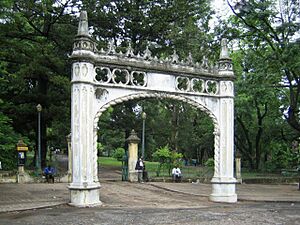Maputo facts for kids
Quick facts for kids
Maputo
|
|||
|---|---|---|---|
|
City and province
|
|||
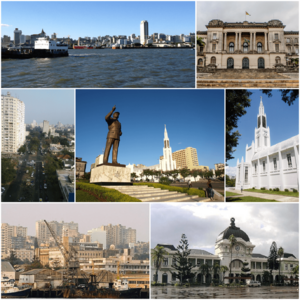
Clockwise, from top: Maputo skyline, Maputo City Hall, Our Lady of the Immaculate Conception Cathedral, Maputo Railway Station, Port of Maputo, Avenida 24 de Julho, and the Samora Machel Statue in Independence Square
|
|||
|
|||
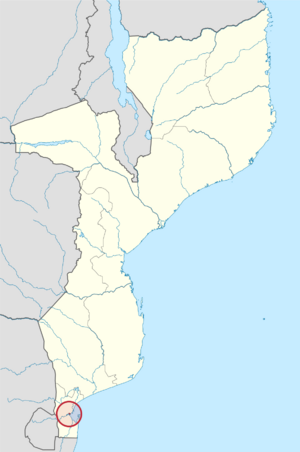
Location in Mozambique
|
|||
| Country | |||
| Founded | 1781 | ||
| Established (town) | 9 December 1876 | ||
| Elevated (city) | 10 November 1887 | ||
| Elevated (capital) | 1898 | ||
| Area | |||
| • City and province | 347.69 km2 (134.24 sq mi) | ||
| Elevation | 47 m (154 ft) | ||
| Population
(2017 census)
|
|||
| • City and province | 1,088,449 | ||
| • Estimate
(2020)
|
1,124,988 | ||
| • Density | 3,130.52/km2 (8,108.00/sq mi) | ||
| • Metro | 1,766,823 | ||
| Time zone | UTC+2 (CAT) | ||
| Postal code |
0101-XX, 0102-XX, 0103-XX, 0104-XX, 0105-XX, 0106-XX, 0107-XX
|
||
| Area Code & Prefix | (+258) 21-XX-XX-XX | ||
| ISO 3166 code | MZ | ||
| HDI (2021) | 0.610 medium · 1st |
||
Maputo is the capital and largest city of Mozambique. It is located near the southern end of the country. The city is close to the borders of Eswatini and South Africa. Maputo has a population of over 1 million people (as of 2017). It covers a land area of about 347 square kilometers. The larger Maputo area, including the nearby city of Matola, has a total population of over 2.7 million.
Maputo is an important port city. Its economy mainly focuses on trade. The city is also known for its lively culture and unique buildings. Before 1976, Maputo was called Lourenço Marques.
The city sits on a large natural bay on the Indian Ocean. Several rivers meet here, including the Tembe, Mbuluzi, Matola, and Infulene. Maputo is divided into seven main areas. Each of these areas has smaller neighborhoods called bairros. Even though it's surrounded by Maputo Province, Maputo City is managed as its own separate province. It is the smallest and most crowded province in Mozambique. Maputo is a diverse city, with influences from Bantu, Portuguese, Arabic, Indian, and Chinese cultures. About half of Maputo's people speak Portuguese as their first language.
The area where Maputo stands today was first a fishing village. It was settled by ancient Tsonga people. The city was later named Lourenço Marques after a Portuguese explorer. He explored the area in 1544. The modern city began with a Portuguese fort built in 1781. A town grew around this fort starting around 1850. In 1877, it became a city. By 1898, it was made the capital of the colony of Portuguese Mozambique.
In the late 1800s and early 1900s, Lourenço Marques grew a lot. Its port became very important for trade. After Mozambique gained independence in 1975, the city became the national capital. It was then renamed Maputo. During the Mozambican Civil War, the city's economy faced many challenges. After the war ended, the government worked to rebuild the city. They also helped people find new homes and jobs.
Maputo has many famous places. These include Independence Square, City Hall, Maputo Fortress, the central market, Tunduru Gardens, and Maputo Railway Station. The city is known for its beautiful wide streets. These streets are lined with jacaranda and acacia trees. This is why it's sometimes called the City of Acacias or the Pearl of the Indian Ocean.
The city's buildings show a mix of styles. You can see old Portuguese colonial designs. There are also modern styles like art deco and Brutalist. The historic Baixa de Maputo district is the city's downtown area. Maputo has a lively cultural scene. It has many restaurants, music places, and a local film industry.
Maputo's economy is built around its port. Many of Mozambique's goods are shipped through here. Important exports include cotton, sugar, and hardwood. Besides trade, the city also has strong manufacturing and service industries. Several colleges and universities are in Maputo. These include Eduardo Mondlane University, the oldest in the country.
Contents
- History of Maputo
- Geography of Maputo
- Administrative Divisions
- City Infrastructure
- Getting Around Maputo: Transport Options
- Maputo's Architecture
- Culture in Maputo
- Famous Landmarks
- Places to Worship
- City Parks
- Education in Maputo
- Notable People from Maputo
- Maputo's Twin Cities
- Images for kids
- See also
History of Maputo
Maputo is located on the northern side of the Espírito Santo Estuary. This estuary is part of Delagoa Bay, which opens into the Indian Ocean. The city was named after a Portuguese explorer. He explored this area in 1544. The Portuguese built forts and trading posts here. They were all named "Lourenço Marques." The current city started around 1850. It grew around a Portuguese fort finished in 1787.
On December 9, 1876, Lourenço Marques became a village. Then, on November 10, 1887, it was made a city. There was a disagreement between Portugal and Britain over who owned Lourenço Marques. This was settled on July 24, 1875. The French President, Patrice de MacMahon, decided that Portugal should own it.
In 1871, the town was described as a simple place. It had narrow streets and some basic houses. But the growing importance of the Transvaal made Portugal more interested in developing its port. In 1876, the Portuguese government sent a group to improve the area. They planted trees and built a hospital and a church. In 1898, Lourenço Marques became the capital of Mozambique. It took over from the Island of Mozambique.
The city grew even more after 1895. This was when a railroad to Pretoria, South Africa, was opened. The Witwatersrand Gold Rush in 1886 also helped the city's economy. Lourenço Marques became the closest port for exporting gold from South Africa.
In the early 1900s, Lourenço Marques had a well-equipped seaport. It had piers and cranes. This allowed large ships to unload goods directly onto trains. The city became a busy and diverse place under Portuguese rule. Ships from Britain, Portugal, and Germany used its port. Most imported goods were sent to cities like Southampton and Lisbon.
As the city's population grew, Portugal built many schools and the first university. The University of Lourenço Marques opened in 1962. Different communities, like Portuguese, Indian, and Chinese, helped the city's economy. They developed industries and businesses. Many tourists from South Africa and Rhodesia (now Zimbabwe) visited the city. They enjoyed its beaches, hotels, and restaurants.
The Mozambique Liberation Front, or FRELIMO, was formed in 1962. It fought for Mozambique's independence from Portugal. The Mozambican War of Independence lasted over 10 years. It ended in 1974 when a new government took power in Portugal. This new government gave independence to most Portuguese territories.
Independence and New Beginnings
The People's Republic of Mozambique became independent on June 25, 1975. The capital city was renamed Maputo in February 1976. The name Maputo comes from the Maputo River. This river marks the border with South Africa. It became a symbol during the fight for independence. The saying was "Long live Mozambique, united from Rovuma to Maputo." The Rovuma River marks the northern border with Tanzania.
After independence, statues of Portuguese heroes were removed from the capital. They were stored at the fortress. Soldiers from FRELIMO took over from the Portuguese army.
Many Portuguese people left Mozambique after independence. This caused problems for the country's economy and management. The new government faced challenges in maintaining the city's services. The country also entered a long and difficult period. The Mozambican Civil War lasted from 1977 to 1992. This war greatly affected the city's economy and stability. In 1983, the government started "Operation Production." This program aimed to help people find jobs and homes in rural areas.
Since the peace agreement in 1992, the city and country have become more stable. This stability has made Mozambique an attractive place for foreign investment. In 2003, an important agreement on women's rights was signed in Maputo. It is known as the Maputo Protocol.
Geography of Maputo
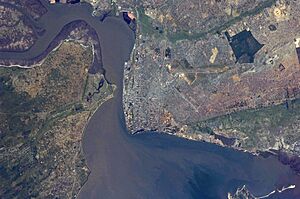
Maputo is on the west side of Maputo Bay. It is near where four rivers meet: the Tembe, Umbeluzi, Matola, and Infulene. The bay is about 95 kilometers long and 30 kilometers wide. To the east of the city and bay is the island of Inhaca. Maputo covers an area of about 346 square kilometers. It borders the city of Matola to the northeast and east. It also borders districts like Marracuene, Boane, and Matutuíne. These are all part of Maputo Province. The city is about 120 kilometers from the South African border. It is also about 80 kilometers from the border with Eswatini.
Maputo's Climate
Maputo has a tropical savanna climate. This means it has enough rain to avoid being a dry, hot area. Maputo gets about 830 millimeters of rain each year. Most of the rain falls during the summer. Winters are much drier. The city has a warm climate. The average temperature is about 22.8 degrees Celsius. January is the hottest month, averaging 26.8 degrees Celsius. July is the coolest month, averaging 18.8 degrees Celsius.
Climate Change and Maputo
Maputo is especially at risk from climate change. This includes impacts like cyclones and flooding. These can be caused by rising sea levels. Many people in Maputo live in crowded neighborhoods. This makes them even more vulnerable to climate change effects.
A report from 2022 said Maputo is one of 12 major African cities that will be most affected by future sea level rise. By 2050, the city could face billions of dollars in damages. These costs could increase even more without steps to adapt. Sea level rise is expected to continue for thousands of years.
Administrative Divisions
Maputo is divided into seven main administrative areas. Each of these areas has several smaller city neighborhoods called bairros.
| Administrative Division | City Quarters or Bairros |
|---|---|
| KaMpfumo | Central A/B/C – Alto Maé A/B – Malhangalene A/B – Polana Cimento A/B – Coop – Sommerschield |
| Nlhamankulu | Aeroporto A/B – Xipamanine – Minkadjuíne – Unidade 7 – Chamanculo A/B/C/D – Malanga – Munhuana |
| KaMaxaquene | Mafalala – Maxaquene A/B/C/D – Polana Caniço A/B – Urbanização |
| KaMavota | Mavalane A/B – FPLM – Hulene A/B – Ferroviário – Laulane – 3 de Fevereiro – Mahotas – Albazine – Costa do Sol |
| KaMubukwana | Bagamoyo – George Dimitrov (Benfica) – Inhagoia A/B – Jardim – Luís Cabral – Magoanine – Malhazine – Nsalene – 25 de Junho A/B(Choupal) – Zimpeto |
| KaTembe | Gwachene – Chale – Inguice – Ncassene – Xamissava |
| KaNyaka | Ingwane – Ribjene – Nhaquene |
City Infrastructure
The central part of Maputo was a planned city. It has square blocks and wide streets. You can still see Portuguese designs from the 1970s. After Mozambique became independent in 1975, many Portuguese people left. This led to a lack of skilled workers and money. The city's buildings and services suffered for many years.
Slowly, the city's older buildings are being repaired. Most new building projects focus on new construction. Property prices in Maputo are high. Many businesses want to be close to the airport and banks.
Maputo faces challenges with its transport and drainage systems. This affects people's lives, especially in informal settlements. Poor planning and a lack of clear rules also make it hard to improve the city's infrastructure. Maputo is a coastal city. This makes it very sensitive to rising sea levels. The growing population also puts more pressure on coastal areas.
PROMAPUTO Project
In 2007, Maputo started a project to fix its infrastructure. This project, called PROMAPUTO, was a partnership. It involved the city council and the World Bank. The first part of the project (PROMAPUTO1) ran from 2007 to 2010. It focused on planning and understanding what was needed. The goal was to gradually improve the city's infrastructure. This phase had a budget of 30 million US dollars.
In 2011, the second phase, PROMAPUTO2, began. This phase lasted until 2015. It spent 105 million US dollars. The plan included new computer systems. These systems would help the city manage its money and land information. Several roads were planned to be expanded and improved. The project also aimed to collect more property tax. This would help pay for future improvements.
New Building Projects
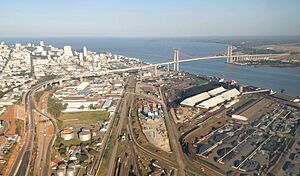
Mozambique is one of the fastest-growing developing countries. Maputo is seeing many new building projects. One example is Edificio 24, a building with different uses. It is located in the city center. The Maputo Business Tower is a modern 19-story building. A Radisson Blu hotel with 256 rooms was also built. It is in a popular spot along the beach. A 15-story building for Vodacom, a phone company, was also planned. The Maputo waterfront is also being redeveloped.
Rehabilitation Efforts
In February 2011, President Armando Guebuza announced plans to restore the Vila Algarve building. This building was once used by the Portuguese Secret Police. It was a place where political prisoners were questioned. The plan is to turn it into a museum for civil war veterans. The building has changed owners many times. It has also been used by people without homes.
Sports Facilities
Maputo has several stadiums for football. These can also be used for other events. The new Estádio do Zimpeto can hold 32,000 people. The Estádio do Maxaquene holds 15,000, and the Estádio do Costa do Sol holds 10,000. The largest stadium in the Maputo area is the Estádio da Machava. It opened in 1968 and was very modern for its time. This stadium was where Portugal officially handed over the country to Samora Machel in 1975. A newer stadium, the Estádio do Zimpeto, opened in 2011. It was built for the 2011 All-Africa Games and can hold 42,000 spectators.
Motorsport became popular in the city in the 1950s. At first, races were held on city streets. Later, a special race track was built in the Costa Do Sol area. It was called Autódromo de Lourenço Marques. The track was improved in 1970 for safety. It hosted many international and local races. After 1975, the track was not used much. But since 2000, interest has grown again. Now, events like go-karting and drag racing are planned.
The city's main basketball arena is the Pavilhão do Maxaquene. It can hold up to 3,500 people. It is home to Ferroviário de Maputo. This team plays in the Basketball Africa League.
Street Names in Maputo
After Mozambique gained independence in 1975, many street names were changed. This was to remove names linked to the colonial past. New names often reflected the country's new political ties.
| Street names in Lourenço Marques and Maputo | |
|---|---|
| Old Name (Lourenço Marques) | New Name (Maputo) |
| Avenida 18 de Maio | Avenida Mártires de Inhaminga |
| Avenida 31 de Janeiro | Avenida Agostinho Neto |
| Avenida 5 de Outubro | Avenida Josina Machel |
| Praça 7 de Março | Praça 25 de Junho |
| Avenida Afonso de Albuquerque | Avenida Ahmed Sekou Touré |
| Rua Aires de Ornelas | Rua de Kassuende |
| Rua Alexandre Herculano | Rua Timor Leste |
| Avenida Almirante Canto e Castro | Avenida da Tanzania |
| Avenida Álvares Cabral | Avenida Zedequias Manganhela |
| Museu Álvaro de Castro | Museu de História Natural |
| Avenida Alves Correia | Avenida da Zambia |
| Casa Amarela | Museu Nacional da Moeda |
| Avenida Anchieta | Avenida Olof Palme |
| Avenida Andrade Corvo | Avenida Ho Chi Min |
| Escola Andrade Corvo | Escola Primária do 1º e 2º Graus 16 de Junho |
| Avenida de António Enes | Avenida Julius Nyerere |
| Liceu António Enes | Escola Secundária Francisco Manyanga |
| Rua António de Oliveira Salazar | Rua da Mesquita |
| Cabaret Aquário | Escola Nacional de Dança |
| Rua Major Araújo | Rua Bagamoyo |
| Edifício do Atneu Grego | Palácio dos Casamentos |
| Avenida Augusto de Castilho | Avenida Vladimir Lenine |
| Rua dos Aviadores | Rua da Argélia |
| Edifício do Banco Nacional Ultramarino | Banco de Moçambique |
| Bartolomeu Dias, Rua | Avenida Mártires de Mueda |
| Belegard da Silva, Avenida | Avenida Francisco O. Magumbwé |
| Caldas Xavier, Avenida | Avenida Marian N'gouabi |
| Câmara Municipal, Edifício da | Conselho Executivo |
| Consiglieri Pedroso, Rua | Rua Revolução de Outubro |
| Couceiro da Costa, Avenida | Avenida Armando Tivane |
| Desportivo de Lourenço Marques, Grupo | Grupo Desportivo de Maputo |
| Dicca, Cinema, Estudio 222 | Matchedje Cine-Estúdio 222 |
| Diogo Cão, Avenida | Avenida Lucas Luali |
| Direcção Geral das Alfândegas, Edifício da | Reitoria da Universidade Eduardo Mondlane |
| Doutor Serrão, Avenida do | Avenida Emília Daússe |
| Dr. Brito Camacho, Rua do | Avenida Patrice Lumumba |
| Dom João de Castro, Avenida | Rua Dom João de Castro |
| Dom Luiz 1º, Avenida | Avenida Samora Machel |
| Dom Manuel I, Avenida | Avenida da Marginal |
| Duques de Connaught, Avenida dos | Avenida Friedrich Engels |
| Eduardo Costa, Rua | Rua de Mukumbura |
| Estâncias, Estrada das | Rua das Estâncias |
| Fazenda, Edifício da | Conselho de Ministros |
| Fernandes Tomaz, Avenida | Avenida Mártires da Machava |
| Fonte Luminosa, Praça da | Praça Robert Mugabe |
| Funchal, Prédio | Hotel Rovuma |
| Gago Coutinho, Aeroporto | Aeroporto de Mavalane |
| General Bettencourt, Avenida do | Rua da Base Ntchinga |
| General Botha, Rua do | Avenida Tomás Nduda |
| General Craveiro Lopes, Avenida | Avenida dos Accordos de Lusaka |
| General Machado, Avenida do | Avenida Guerra Popular |
| General Machado, Escola | Universidade Pedagógica |
| General Rosado, Rua do | Avenida Kim Il Sung |
| Gomes Freire, Avenida | Avenida Paulo Samuel Kankhomba |
| Governador Simas, Rua do | Rua Mateus Sansão Muthemba |
| Guerra Junqueiro, Rua | Rua José Mateus |
| Heróis de Marracuene, Rua dos | Rua da Resistência |
| Hotel Clube | Centro Cultural Franco-Moçambicano |
| Infante, Cinema | Cinema Charlot |
| João Albasini, Largo | Praça 21 de Outubro |
| João Belo, Escola Primária | Escola Primária 7 de Setembro |
| João das Regras, Rua | Rua de Nachingwea |
| João de Deus, Avenida | Avenida Romão Fernandes Farinha |
| José Cabral, Parque | Parque dos Continuadores |
| Joaquim de Araújo, Escola | Escola Secundária Estrela Vermelha |
| Lapa, Rua | Rua Joaquim Lapa |
| Lar Moderno, Edifício do | Centro de Estudos Brasileiro |
| Latino Coelho, Avenida | Avenida Maguiguana |
| Lidemburgo, Rua de | Avenida Rio Tembe |
| Lisboa, Miradouro de | Miradouro |
| Lisboa, Rua de | Avenida Milagre Mabote |
| Luciano Cordeiro, Avenida | Avenida Albert Luthuli |
| Mac Mahon, Praça | Praça dos Trabalhadores |
| Manuel de Arriaga, Avenida | Avenida Karl Marx |
| Manuel Rodrigues, Cinema | Cine Teatro África |
| Massano de Amorim, Avenida | Avenida Mao Tsé Tung |
| Mendonça Barreto, Avenida | Avenida do Rio Limpopo |
| Mouzinho de Albuquerque, Praça | Praça da Independência |
| Nevala, Rua de | Avenida Nkwam Nkruma |
| Nossa Senhora de Fátima, Avenida | Avenida Kenneth Kaunda |
| Oliveira Salazar, Estádio | Estádio da Machava |
| Paiva de Andrada, Avenida | Avenida Mahomed Siad Barre |
| Paiva Manso, Avenida | Avenida Filipe Samuel Magaia |
| Pero da Covilhã, Rua | Rua Belmiro O. Muianga |
| Pero de Alenquer, Rua | Avenida Amílcar Cabral |
| Pesca Desportiva, Clube de | Escola Náutica de Moçambique |
| Pinheiro Chagas, Avenida | Avenida Eduardo Mondlane |
| Porto, Rua do | Rua Malhangalene |
| Princesa Patrícia, Rua da | Avenida Salvador Allende |
| Rebelo da Silva, Escola Primária | Escola Primária 3 de Fevereiro |
| República, Avenida da | Avenida 25 de Setembro |
| Sagres, Rua de | Avenida 10 de Novembro |
| Salazar, Liceu | Escola Secundária Josina Machel |
| Sporting Clube de Lourenço Marques | Clube de Desportos Maxaquene |
| Turismo, Hotel | Hotel Ibis |
| Vasco da Gama, Jardim | Jardim Tunduro |
| Vasco da Gama, Mercado | Mercado Municipal (Bazar da Baixa) |
Getting Around Maputo: Transport Options
Air Travel
Maputo International Airport is Mozambique's main airport. A new terminal opened in 2010. It can handle 900,000 passengers each year. Work has also started on a new terminal for flights within the country.
Bus Services
Most people in Maputo use minibus taxis called chapas. These are the main way to get around the city. To help with public transport, the state-owned company, Transporte de Moçambique (TPM), bought many new buses. Maputo has three main bus stations. These are located at Baixa, Museu, and Junta.
Ferry Boats
Ferry boats travel from Maputo to the KaTembe district. They run during the week. Each ferry can carry about 20 vehicles.
Train Lines
Maputo is at the end of three railway lines. These are the Goba railway, Limpopo railway, and Pretoria–Maputo railway.
Trams in the Past
Maputo had one of Africa's first electric tram systems. It started in February 1904. The trams ran from the Central Railway Station to the City Municipality building. Trams became less popular in the mid-1900s. Cars and buses became more common. Trams have not been used since 1936. However, you can still see parts of the old tracks in some streets.
Maputo's Important Port
The main Port of Maputo handled 17 million tons of goods in 1971. This was its busiest time. Today, the port is managed by the Maputo Port Development Company (MPDC). This company is a joint venture between Grindrod and DP World. The government has allowed them to manage the port until 2030. This is to help upgrade its old infrastructure.
In 2010, the port's channel was deepened. Now, larger ships can use the port. Investments are also being made for special terminals. These terminals will handle things like liquids, granite, metals, and coal. A new terminal for vehicles is also planned. It will be able to move 57,000 vehicles per year. By 2030, the port aims to handle 50 million tons of goods each year. The total investment will be over 500 million US dollars.
Other Ways to Get Around
Recently, three-wheeled vehicles, like tuk-tuks, have become popular. Locals call them "tchopelas." These bikes are cheaper to own and run. They have become a popular alternative to regular taxis.
Maputo's Architecture
Maputo has always attracted talented architects. The city has amazing buildings by famous designers. Early buildings in the city showed classical European designs. Examples include the Central Train Station. It was built between 1913 and 1916. The Hotel Polana was designed by Herbert Baker.
In the 1960s and 1970s, new architectural styles came to Maputo. These included modernist and brutalist designs. These styles focused on clean, straight, and useful structures. However, architects like Pancho Guedes mixed these styles with local art. This gave Maputo's buildings a unique Mozambican feel. Many buildings from this time show these special designs.
Loss of Historic Buildings
In recent years, many old and important buildings have been torn down. This is happening because of new investments in real estate. Single homes are being replaced by tall apartment buildings. It is hard to expand the city legally. Also, there are not enough rules to protect historic buildings. The local government has struggled to control this situation.
Many acacia trees that once lined the streets have also been removed. These trees gave the city its special look. The removal often happens in winter. It is sometimes done under the excuse of pruning overgrown trees. But without proper care, the pruning can be too much. This leads to the trees dying.
Culture in Maputo
Maputo is a mix of many cultures. The Bantu and Portuguese cultures are the strongest. But you can also feel the influence of Arab, Indian, and Chinese cultures.
Film and Cinema
Before television arrived in 1981, movies were a very popular form of entertainment. Maputo had many movie theaters by the time of independence. In the 1950s and 1960s, there was racial segregation. Most movie-goers were European or South Asian. Black Mozambicans also enjoyed movies in simple, temporary theaters.
In the late 1970s and 1980s, local films focused on Socialist ideas. These films often showed family life and farming. Maputo has also been a setting for many Hollywood movies. These include The Interpreter and Blood Diamond.
Associação Núcleo de Arte
The Associação Núcleo de Arte is an important cultural center in Maputo. It is the oldest group of artists in Mozambique. Located in an old house, it has been a key part of the city's culture for decades. Two famous Mozambican artists, Malangatana Ngwenya and Alberto Chissano, started their careers here.
Over a hundred artists are members of the Núcleo. They often hold exhibitions. In recent years, they have worked with artists from other countries. The Núcleo is famous for its project of turning weapons into art. This project helped with healing after the Mozambican Civil War. Their art, like the Chair of the African King and the Tree of Life, has been shown worldwide.
Maputo also hosts the Dockanema Documentary Film Festival. This festival shows documentary films from all over the world.
Handicraft
Maputo is known for special small sculptures. They are called "pshikelekedanas." These are made from soft wood using a penknife. They often show important animals in Mozambique, like hippos.
Famous Landmarks
Over five centuries of Portuguese rule, Maputo gained many examples of Portuguese architecture. Most of the important buildings were once colonial offices or are now government buildings.
Some of the city's notable landmarks include:
- Fortress of Maputo
- Maputo Railway Station
- Independence Square
- Maputo City Hall
- Samora Machel Statue
- The Museum of Natural History
- Vila Algarve – a building with a historic past
- Tunduru Gardens
Places to Worship
Maputo has many places of worship. Most are Christian churches and temples. These include Catholic, Reformed, Presbyterian, and Baptist churches. There are also Muslim mosques in the city.
City Parks
Maputo does not have many large parks yet. However, in the city center is the Jardim Tunduru (Tunduru Gardens). It was once called the Vasco Da Gama Garden. A British architect, Thomas Honney, designed it in the 1880s. The park's entrance has a special Neo-Manueline design. After independence, the name was changed. A statue of Mozambique's first president was also placed there.
Education in Maputo
Maputo offers many choices for education. There are pre-schools, primary schools, secondary schools, and universities. The quality of education can vary a lot between private and public schools.
Higher Education
Mozambique's largest university is the Universidade Eduardo Mondlane. It was founded in 1968. Most of its departments are in Maputo. Nearly 8,000 students attend its 10 faculties. Some faculties are also in other cities.
Since the 1990s, many private universities have also opened. These include ISCTEM, ISTEG, and ISUTC.
Secondary Education
In secondary education, there is also a big difference between private and public schools.
Some notable private schools in Maputo are:
- Escola Portuguesa de Moçambique
- American International School of Mozambique
- The Aga Khan Academy, Maputo
Notable People from Maputo
- Al Bowlly, a singer
- Carlos Cardoso, a journalist
- Alberto Chissano, a sculptor
- Mia Couto, a writer
- José Craveirinha, a poet
- Eusébio, a famous footballer
- Pancho Guedes, an architect
- Teresa Heinz, a philanthropist
- Malangatana, an artist
- Mariza, a fado singer
- Maria Mutola, a runner
- Neyma, a singer
- Ricardo Rangel, a photojournalist
Maputo's Twin Cities
Maputo is twinned with several cities around the world. This means they have special friendly relationships.
 Addis Ababa, Ethiopia
Addis Ababa, Ethiopia Ankara, Turkey
Ankara, Turkey Bissau, Guinea-Bissau
Bissau, Guinea-Bissau Cape Town, South Africa
Cape Town, South Africa Charles County, United States
Charles County, United States Chengdu, China
Chengdu, China Chennai, India
Chennai, India Dili, East Timor
Dili, East Timor Durban, South Africa
Durban, South Africa Guarulhos, Brazil
Guarulhos, Brazil Harare, Zimbabwe
Harare, Zimbabwe Jakarta, Indonesia
Jakarta, Indonesia Lagos, Nigeria
Lagos, Nigeria Lisbon, Portugal
Lisbon, Portugal Luanda, Angola
Luanda, Angola Mbabane, Eswatini
Mbabane, Eswatini Port Louis, Mauritius
Port Louis, Mauritius Rio de Janeiro, Brazil
Rio de Janeiro, Brazil Shanghai, China
Shanghai, China
Cooperation Agreements
Maputo also has a cooperation agreement with:
 Barcelona, Spain
Barcelona, Spain
Images for kids
See also
 In Spanish: Maputo para niños
In Spanish: Maputo para niños





